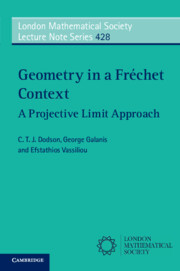Book contents
- Frontmatter
- Contents
- Preface
- 1 Banach manifolds and bundles
- 2 Fréchet spaces
- 3 Fréchet manifolds
- 4 Projective systems of principal bundles
- 5 Projective systems of vector bundles
- 6 Examples of projective systems of bundles
- 7 Connections on plb-vector bundles
- 8 Geometry of second order tangent bundle
- Appendix: Further study
- References
- List of Notations
- Subject index
Preface
Published online by Cambridge University Press: 05 November 2015
- Frontmatter
- Contents
- Preface
- 1 Banach manifolds and bundles
- 2 Fréchet spaces
- 3 Fréchet manifolds
- 4 Projective systems of principal bundles
- 5 Projective systems of vector bundles
- 6 Examples of projective systems of bundles
- 7 Connections on plb-vector bundles
- 8 Geometry of second order tangent bundle
- Appendix: Further study
- References
- List of Notations
- Subject index
Summary
The aim of the authors is to lay down the foundations of the projective systems of various geometrical structures modelled on Banach spaces, eventually leading to homologous structures in the framework of Fréchet differential geometry, by overcoming some of the inherent deficiencies of Fréchet spaces. We elaborate this brief description in the sequel.
Banach spaces, combining a metric topology (subordinate to a norm), and a linear space structure (for representing derivatives as linear approximations to functions in order to do calculus), provide a very convenient setting for many problems in functional analysis, which we need for handling calculus on function spaces, usually infinite dimensional. They are a relatively gentle extension from experience on finite dimensional spaces, since many topological properties of spaces and groups of linear maps, as well as many of the existence and uniqueness theorems for solutions of differential equations carry over to the infinite dimensional case.
Manifolds and fibre bundles modelled on Banach spaces arise from the synthesis of differential geometry and functional analysis, thus leading to important examples of global analysis. Indeed, many spaces of (differentiable) maps between appropriate manifolds admit the structure of Banach manifolds (see, for instance, J. Eells [Eel66, § 6]).
On the other hand, as mentioned also in [Eel66], Riemannian manifolds, represented as rigid maps on infinite dimensional function spaces, arise as configuration spaces of dynamical systems, with metrics interpreted as kinetic energy. Much of the calculus of variations and Morse theory is concerned with a function space in differential geometry— the Euler-Lagrange operator of a variational problem is interpreted as a gradient vector field, with integral curves the paths of steepest ascent. Some eigenvalue problems in integral and differential equations are interpretable via Lagrangian multipliers, involving infinite dimensional function spaces from differential geometry—such as focal point theory and geometric consequences of the inverse function theorem in infinite dimensions.
However, in a number of situations that have significance in global analysis and physics, for example, physical field theory, Banach space representations break down. A first step forward is achieved by weakening the topological requirements: Instead of a norm, a family of seminorms is considered. This leads to Fréchet spaces, which do have a linear structure and their topology is defined through a sequence of seminorms.
- Type
- Chapter
- Information
- Geometry in a Fréchet ContextA Projective Limit Approach, pp. vii - xiiPublisher: Cambridge University PressPrint publication year: 2015



